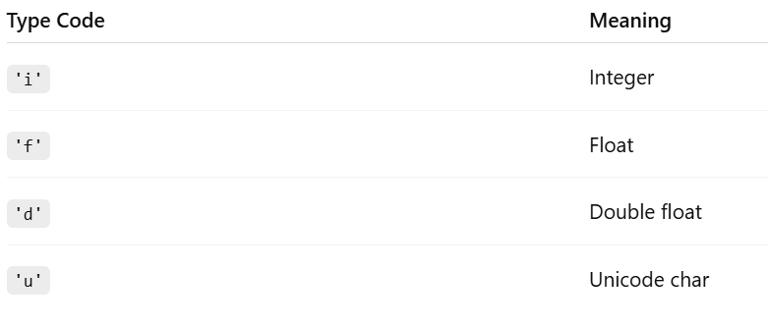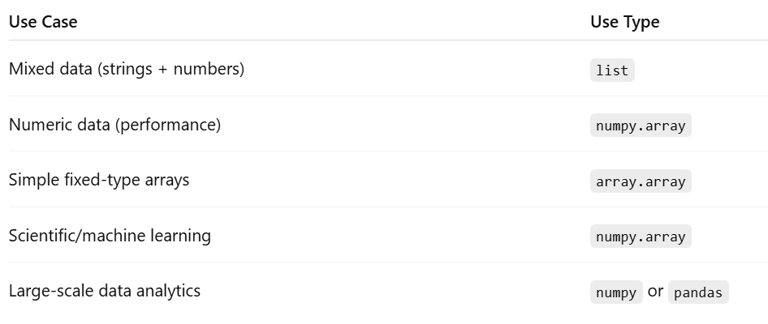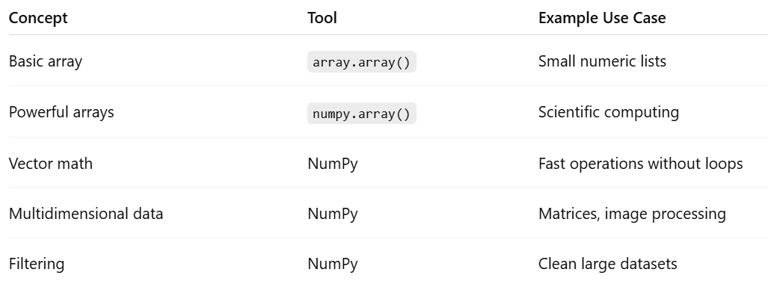🧮 Understanding Arrays in Python: A Practical Guide with Real-World Examples
PYTHON
5/5/20254 min read


When working with large sets of numerical data, performance and memory efficiency become crucial. Python provides arrays — compact, efficient containers for handling numeric data — especially when performance matters.
In this post, we’ll explore:
The difference between lists and arrays
Python's built-in array module
The powerful NumPy array
Real-world examples and performance tips
📦 1. What Is an Array?
An array is a data structure that stores elements of the same type in a contiguous block of memory. This makes operations faster and more efficient than lists in some scenarios.
👥 List vs Array in Python


🧰 2. Using Built-In array Module
Python has a basic array module for one-dimensional numeric arrays.
import array
nums = array.array('i', [1, 2, 3, 4])
print(nums[0]) # 1


🛠️ sum() and len()
import array
data = array.array('f', [12.5, 15.0, 14.7, 13.2])
avg = sum(data) / len(data)
print(f"Average: {avg}")
✅ Use case: Processing sensor data or small-scale numeric data.
⚡ 3. Enter NumPy: Fast, Multidimensional Arrays
While Python's built-in array is useful, NumPy is the industry standard for numerical computing in Python.
📦 Install NumPy (if needed):
pip install numpy
🔍 Create and Use NumPy Arrays
import numpy as np
arr = np.array([1, 2, 3, 4])
print(arr * 2) # [2 4 6 8]
✅ Use case: Fast element-wise operations on large datasets (lists can’t do this).
🧑💻 Real-World Examples with NumPy
📊 1. Element-Wise Math (e.g., Sales Forecast)
sales = np.array([100, 120, 150])
growth = 1.1
forecast = sales * growth
print(forecast) # [110. 132. 165.]
✅ Use case: Sales forecasting or modeling financial growth.
🧮 2. Vectorized Operations
a = np.array([10, 20, 30])
b = np.array([1, 2, 3])
result = a + b # [11 22 33]
✅ Use case: Data processing without loops — faster and cleaner.
📈 3. Basic Statistics
data = np.array([5, 10, 15, 20])
print("Mean:", data.mean())
print("Standard Deviation:", data.std())
print("Max:", data.max())
✅ Use case: Analyze results, scores, experiments.
🧱 4. Multidimensional Arrays (Matrices)
matrix = np.array([[1, 2], [3, 4]])
print(matrix.shape) # (2, 2)
✅ Use case: Represent images, grids, or correlation matrices.
🧰 5. Real-Time Sensor Simulation
import numpy as np
# Simulate 5 sensors, each with 100 readings
data = np.random.rand(5, 100)
# Average reading per sensor
averages = data.mean(axis=1)
print(averages)
✅ Use case: IoT data processing, environmental monitoring.
🧪 Comparison: Lists vs NumPy Arrays (Speed)
import time
lst = list(range(1000000))
arr = np.array(lst)
start = time.time()
_ = [x * 2 for x in lst]
print("List time:", time.time() - start)
start = time.time()
_ = arr * 2
print("NumPy time:", time.time() - start)
✅ NumPy arrays are 10–50x faster for large numeric operations.
🔎 Bonus: Array Filtering and Masking
arr = np.array([5, 10, 15, 20])
print(arr[arr > 10]) # [15 20]
✅ Use case: Filter large datasets based on conditions — no loops needed.
🧹 When to Use Arrays


✨ Summary


🚀 Final Thoughts
For small, casual use — Python lists are fine.
For numeric-heavy operations — use NumPy arrays.
For high-speed, memory-optimized computing — NumPy is the way to go.
🧠 More Real-World Array Examples Using NumPy
📆 1. Calculate Working Days in a Month
import numpy as np
import pandas as pd
# Get all weekdays in May 2025
dates = pd.date_range(start="2025-05-01", end="2025-05-31", freq='B') # B = business day
print("Working days:", len(dates))
✅ Use case: Payroll systems, scheduling reports, project planning.
📊 2. Normalize Data (Min-Max Scaling)
data = np.array([100, 200, 300, 400])
normalized = (data - data.min()) / (data.max() - data.min())
print(normalized) # [0. 0.33 0.66 1. ]
✅ Use case: Feature scaling in machine learning, score normalization.
💰 3. Calculate Compound Interest Over Time
principal = 1000
rate = 0.05 # 5% annual interest
years = np.arange(1, 11) # 10 years
amount = principal (1 + rate) * years
print(amount)
✅ Use case: Financial forecasting, investment tools.
🎯 4. One-Hot Encoding for Categories
categories = np.array(['apple', 'banana', 'apple', 'orange'])
unique = np.unique(categories)
encoded = np.array([np.where(unique == fruit, 1, 0) for fruit in categories])
print(encoded)
✅ Use case: Machine learning preprocessing, NLP tasks.
🎚️ 5. Rolling Average (e.g., Temperature, Stock Prices)
import pandas as pd
temps = [22, 21, 23, 24, 26, 25, 24]
series = pd.Series(temps)
rolling_avg = series.rolling(window=3).mean()
print(rolling_avg)
✅ Use case: Smoothing noisy data in finance, weather, or web traffic.
🏥 6. Patient Vitals Monitoring (Mean per Patient)
# 3 patients, 4 readings each
readings = np.array([
[98.6, 99.1, 98.9, 99.0],
[97.5, 98.0, 98.2, 98.1],
[99.2, 99.3, 99.1, 98.9]
])
avg_per_patient = readings.mean(axis=1)
print(avg_per_patient)
✅ Use case: Hospital patient monitoring, health tech apps.
🖼️ 7. Image Manipulation (Grayscale Inversion)
image = np.array([
[0, 50, 100],
[150, 200, 255]
])
inverted = 255 - image
print(inverted)
✅ Use case: Image processing, filters, computer vision basics.
📏 8. Filter Outliers from Data
data = np.array([10, 12, 13, 12, 99, 13, 12])
mean = data.mean()
std = data.std()
filtered = data[(data > mean - 2*std) & (data < mean + 2*std)]
print(filtered)
✅ Use case: Removing sensor glitches, cleaning survey data, data prep.
🏗️ 9. Combine Two Arrays Element-wise
a = np.array([1, 2, 3])
b = np.array([4, 5, 6])
combined = np.stack((a, b), axis=1)
print(combined)
✅ Use case: Pairing coordinates (x, y), key-value tabulations.
📈 10. Cumulative Sum for Running Total
sales = np.array([100, 200, 150, 250])
running_total = np.cumsum(sales)
print(running_total) # [100 300 450 700]
✅ Use case: Display running balance, daily totals, donations, etc.


Kishore Babu Valluri
Senior Data Scientist | Freelance Consultant | AI/ML & GenAI Expert
With deep expertise in machine learning, artificial intelligence, and Generative AI, I work as a Senior Data Scientist, freelance consultant, and AI agent developer. I help businesses unlock value through intelligent automation, predictive modeling, and cutting-edge AI solutions.
Let's Get in Touch
marketing@deepaiautomation.com
+91 6309397994
© 2025. All rights reserved.
Industries
Manufacturing
Financial Services
Retail
Solutions
DocuMind AI - Intelligent Document Migration
InsightEdge AI - Intelligent Power BI Reporting & Analytics
DCT AI - Digital Control Tower for Intelligent Enterprise Visibility
Inventra AI - Intelligent Inventory Optimization Platform
Maintenix AI - Predictive Maintenance Intelligence Platform
PayPredict AI - Intelligent Customer Payment Prediction Platform
SegMind AI - Intelligent Customer Segmentation & RFM Analytics Platform
DataForge AI - Intelligent ETL & Analytics Modernization Platform
DataSense AI - Intelligent Data Quality & Outlier Detection Agent
